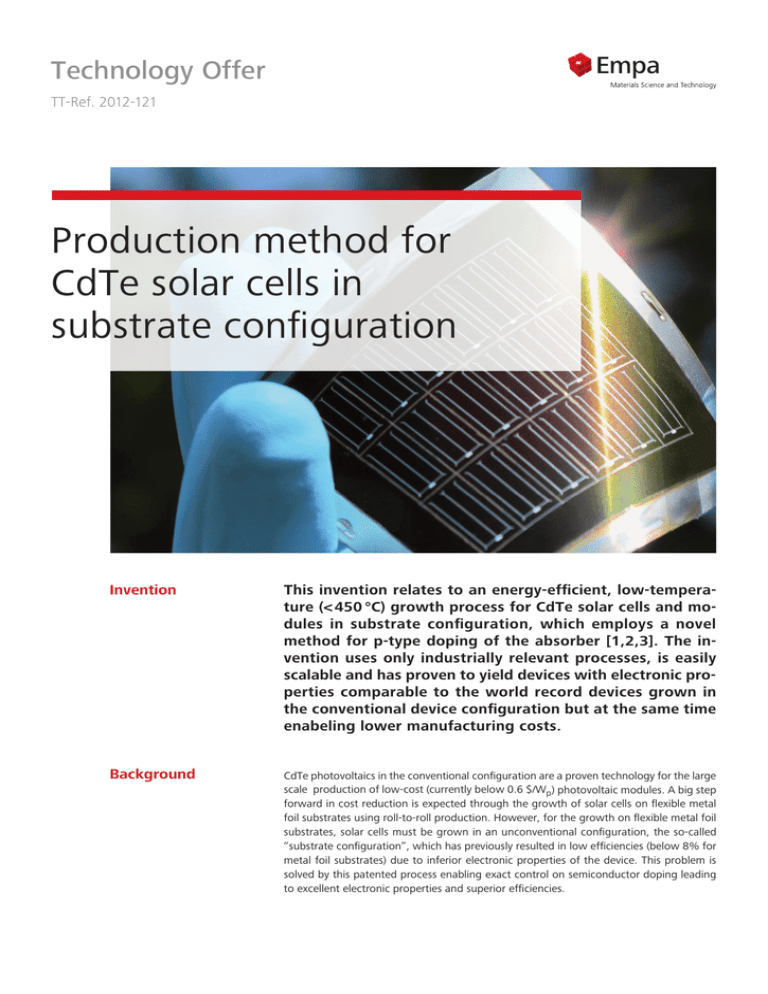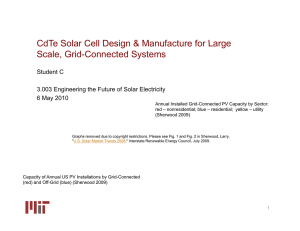Flexible solar cells
advertisement

Technology Offer TT-Ref. 2012-121 Production method for CdTe solar cells in substrate configuration Invention This invention relates to an energy-efficient, low-temperature (< 450 °C) growth process for CdTe solar cells and modules in substrate configuration, which employs a novel method for p-type doping of the absorber [1,2,3]. The invention uses only industrially relevant processes, is easily scalable and has proven to yield devices with electronic properties comparable to the world record devices grown in the conventional device configuration but at the same time enabeling lower manufacturing costs. Background CdTe photovoltaics in the conventional configuration are a proven technology for the large scale production of low-cost (currently below 0.6 $/Wp ) photovoltaic modules. A big step forward in cost reduction is expected through the growth of solar cells on flexible metal foil substrates using roll-to-roll production. However, for the growth on flexible metal foil substrates, solar cells must be grown in an unconventional configuration, the so-called “substrate configuration”, which has previously resulted in low efficiencies (below 8% for metal foil substrates) due to inferior electronic properties of the device. This problem is solved by this patented process enabling exact control on semiconductor doping leading to excellent electronic properties and superior efficiencies. Advantages Compared to state-of-the art substrate configuration CdTe solar cells, the invention enables significantly improved electronic properties of the devices. This yields higher efficiencies and better process reproducibility leading to lower cost/Wp compared to alternative processes. In proof of concept experiments certified world record efficiencies of 13.5% and 11.5% are already reached on glass and flexible metal foil substrates, which significantly exceed the efficiencies achieved with alternative processes. Further optimization of the process should yield efficiencies towards 20%. Applications This invention opens new business opportunities based on a material which has already proven low cost production of high efficiency solar modules. This technology has inherent advantages of industrialization with low investment and low risks. The technology can be applied both on rigid glass substrate and on flexible low cost substrates, e.g. metal foil or polyimide film. The growth on flexible foils enables roll-to-roll production, which significantly reduces production costs. Additionally to the advantages in processing, the flexible and lightweight product offers unique selling propositions: Low weight as well as module flexibility and rollability. Structure of CdTe solar cells in substrate configuration CdTe solar cells on flexible metal foil Ownership Empa, Swiss Federal Laboratories for Materials Testing and Research, Überlandstrasse 129, CH-8600 Dübendorf; Patent pending References [1] Kranz et al., Doping of polycrystalline CdTe for high efficiency solar cells on flexible metal foil, Nat. Commun. 4, 2306 (2013). [2] Kranz et al., Tailoring Impurity Distribution in Polycrystalline CdTe Solar Cells for Enhanced Minority Carrier Lifetime, Adv. Energy Mater. DOI: 10.1002/aenm.201301400 (2013). [3] Gretener et al., CdTe/CdS thin film solar cells grown in substrate configuration, Prog. Photovolt.: Res. Appl. 21, 1580 (2013). Keywords Photovoltaics, solar cells, CdTe, flexible, metal foil substrate, substrate configuration, doping, copper Contact Empa, Technology Transfer Dr Andreas Kündig, andreas.kuendig@empa.ch Phone +41 58 765 48 30, Fax +41 58 765 69 08 Technical Information Prof. Dr Ayodhya N. Tiwari, Head of Laboratory for Thin Films and Photovoltaics ayodhya.tiwari@empa.ch Phone +41 58 765 41 30, Fax +41 58 765 11 22 Empa CH-8600 Dübendorf Überlandstrasse 129 Telefon+41 58 765 11 11 Telefax +41 58 765 11 22 CH-9014 St. Gallen Lerchenfeldstrasse 5 Empa is an interdisciplinary research and service institution within the ETH Domain covering selected fields of materials science and technology development including important environmental issues. Empa’s R&D activities focus on the requirements of industry and the needs of society, thus linking research to engineering, and science to industry and society. As a result, Empa is capable of providing its partners with customized services and solutions that not only enhance their innovative edge, but also help to improve the quality of life for the public at large. Safety, reliability and sustainability of materials and systems are cross-sectional topics and a hallmark of all Empa activities. As such, Empa plays a key role in Switzerland‘s research and innovation landscape. © Empa 2014 Telefon+41 58 765 74 74 Telefax +41 58 765 74 99 CH-3602 Thun Feuerwerkerstrasse 39 Telefon+41 58 765 11 33 Telefax +41 58 765 69 90 www.empa.ch


